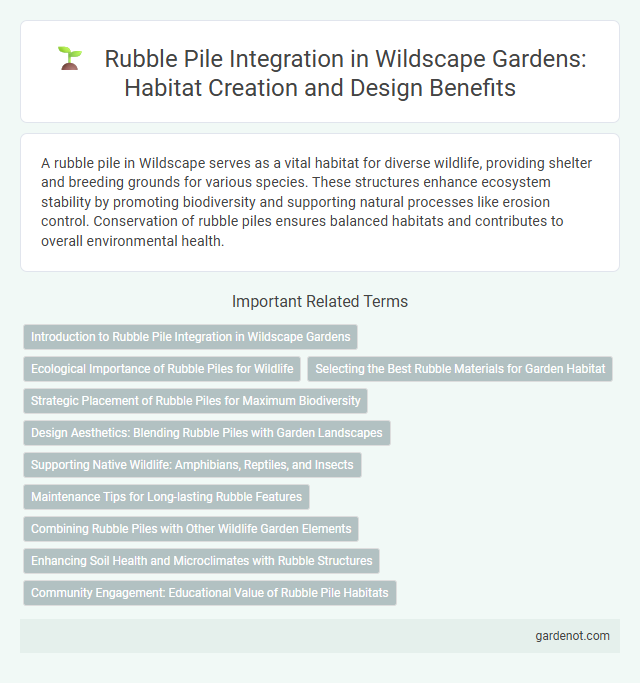A rubble pile in Wildscape serves as a vital habitat for diverse wildlife, providing shelter and breeding grounds for various species. These structures enhance ecosystem stability by promoting biodiversity and supporting natural processes like erosion control. Conservation of rubble piles ensures balanced habitats and contributes to overall environmental health.
Introduction to Rubble Pile Integration in Wildscape Gardens
Rubble pile integration in Wildscape Gardens enhances habitat complexity by providing essential microhabitats for pollinators, amphibians, and reptiles. These piles composed of natural stones and organic materials support biodiversity by offering shelter, breeding sites, and temperature regulation. Incorporating rubble piles mimics natural ecosystems, promoting ecological balance and resilience within the garden environment.
Ecological Importance of Rubble Piles for Wildlife
Rubble piles serve as critical microhabitats that support diverse wildlife by providing shelter, breeding grounds, and hunting territories for various species, including reptiles, amphibians, and small mammals. These structures foster biodiversity by offering refuge from predators and harsh environmental conditions, while also supporting complex food webs through the accumulation of organic matter and invertebrates. The ecological significance of rubble piles extends to their role in maintaining ecosystem balance and promoting species resilience in natural and urban landscapes.
Selecting the Best Rubble Materials for Garden Habitat
Choosing the best rubble materials for a garden habitat involves prioritizing natural stones like limestone, granite, and sandstone due to their durability and ability to support diverse microhabitats. Incorporating a variety of sizes and shapes creates crevices and voids that shelter insects, small mammals, and reptiles, promoting biodiversity. Avoid using treated or painted rubble, ensuring materials are free from contaminants that could harm the ecosystem.
Strategic Placement of Rubble Piles for Maximum Biodiversity
Strategic placement of rubble piles in Wildscape enhances habitat complexity, promoting diverse microhabitats for reptiles, amphibians, and invertebrates. Positioning rubble piles near water sources or under partial canopy cover increases humidity levels and shelter availability, supporting species richness and ecological interactions. Optimizing pile size and composition with varied rock types encourages colonization by mosses, lichens, and small mammals, maximizing biodiversity outcomes.
Design Aesthetics: Blending Rubble Piles with Garden Landscapes
Rubble piles in Wildscape design aesthetic serve as naturalistic elements that seamlessly integrate with garden landscapes by mimicking organic rock formations and weathered textures. Their strategic placement enhances spatial depth and visual interest, utilizing varied stone sizes and earthy tones that complement surrounding greenery and flora. This approach fosters a harmonious balance between rugged, raw materials and cultivated plant life, enriching the overall ambiance of outdoor environments.
Supporting Native Wildlife: Amphibians, Reptiles, and Insects
Rubble piles create essential microhabitats that support native amphibians, reptiles, and insects by providing shelter, breeding grounds, and protection from predators. These structures maintain soil moisture and temperature regulation, fostering environments ideal for species such as frogs, lizards, and beetles. Incorporating rubble piles into wildscapes enhances biodiversity and promotes ecosystem resilience by supporting diverse native wildlife populations.
Maintenance Tips for Long-lasting Rubble Features
Regularly inspect rubble piles to remove debris and prevent weed growth, which ensures structural integrity and aesthetic appeal. Use appropriate drainage solutions around the rubble to avoid water accumulation that can cause erosion or instability. Incorporate durable, weather-resistant materials during construction to extend the lifespan and reduce maintenance frequency.
Combining Rubble Piles with Other Wildlife Garden Elements
Combining rubble piles with native wildflowers and log piles creates essential habitats that attract diverse species including pollinators, amphibians, and small mammals. Strategically placing rubble piles near ponds or hedgerows enhances shelter and breeding grounds, fostering a balanced ecosystem in your wildlife garden. Integrating these elements supports biodiversity by providing varied microhabitats vital for the survival of different wildlife.
Enhancing Soil Health and Microclimates with Rubble Structures
Rubble piles create essential microhabitats that enhance soil health by promoting moisture retention and organic matter accumulation. These structures support diverse microbial communities and beneficial insects, accelerating nutrient cycling and improving soil fertility. Integrating rubble piles in wildscapes fosters resilient microclimates that buffer temperature extremes and support native plant growth.
Community Engagement: Educational Value of Rubble Pile Habitats
Rubble pile habitats provide unique opportunities for community engagement by fostering hands-on environmental education and raising awareness about marine biodiversity. These complex structures support diverse aquatic life, making them ideal outdoor classrooms for schools and conservation groups. Educational programs centered on rubble piles help participants understand ecosystem dynamics and the importance of habitat preservation.
Rubble pile Infographic

 gardenot.com
gardenot.com